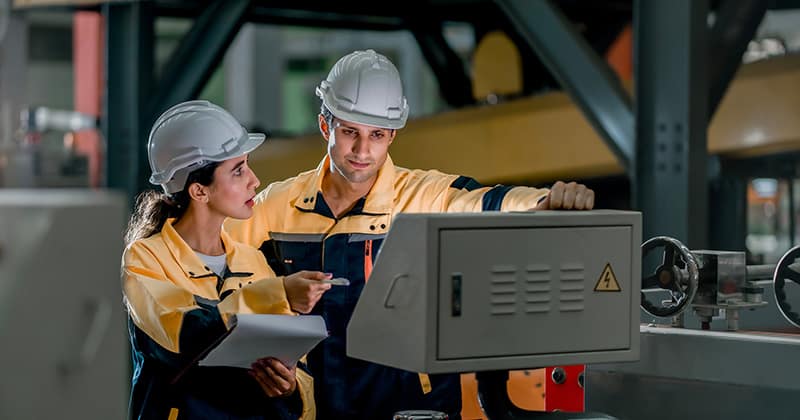If you run an enterprise-level service business, then you most certainly have valuable assets worth taking care of.
Important business assets may include your fleet, power tools, and machinery. These are, essentially, the equipment that makes your service jobs possible.
Equipment management is a crucial factor in service delivery. A well-oiled machine, for example, is durable, easy to work with, and reliable. But equipment management goes beyond routine maintenance.
This article is a detailed overview of equipment lifecycle management. It answers these six questions:
- What is equipment lifecycle management?
- What are the four phases of the equipment lifecycle?
- Why is equipment lifecycle management important to a home service enterprise?
- What challenges do home service providers face in equipment lifecycle management?
- How does equipment lifecycle optimization enhance business performance?
- What does the future hold for equipment lifecycle management?
Let’s dive in.
What Is the Equipment Lifecycle?
The term “equipment lifecycle” refers to the longevity of a particular physical equipment. An equipment lifecycle begins when you first acquire a piece of equipment and ends when you retire the equipment.
Meanwhile, equipment lifecycle management is a 4-stage strategy for maximizing an asset’s usefulness during its lifetime. It starts with drafting a plan to purchase a particular asset and ends with the renewal or disposal of said piece of equipment.
In a nutshell, equipment lifecycle management helps you get the most out of your service equipment.
Toolboxes, power tools, vehicles, and machinery are quite expensive. Proper equipment lifecycle management ensures you invest in the right assets. More importantly, it maximizes your equipment’s ROI throughout its useful lifespan.
Also, equipment and machinery won’t last forever. Even your most dependable assets will one day become obsolete or broken beyond repair. What happens then? You must have a plan for when the time comes to replace or decommission vital equipment.
A Brief History of Equipment Lifecycle Management
“They don’t build them like they used to.”
That often sounds like a cliché old man’s rant about how everything was built better in the olden days. But it’s actually true — at least to some extent.
It must be said; electronics, motor vehicles, tools, and machinery from decades ago were built “different.” They were built to last.
You probably own or know someone who owns an old refrigerator that has run without a hitch for generations. Or a motor from the ’60s that still runs today. Or a vintage record player that, despite falling out of fashion, has outlived modern HiFi and home theater systems.
Why are modern manufactured goods so flimsy, and what does any of this have to do with equipment lifecycle management?
Firstly, modern machines and electronics have more features and capabilities. That means more failure points.
Secondly, modern mass-produced products follow strict product lifecycles. The concept of product lifecycle management (PLM) was first mentioned by Joel Dean in 1950 in a model he described as “the cycle of competitive degeneration.”
Today, PLM is a collection of strategies manufacturers and product designers use to optimize their products’ market competitiveness and returns. PLM mainly involves minimizing the cost of production, complying with regulatory requirements, and meeting market demand. In some cases, PLM includes planned obsolescence.
The merits and justification of planned obsolescence are hotly debated. Designing a product that fails or breaks within a short time can be seen as unethical. In 2015, France became the first country to outlaw planned obsolescence. A handful of other countries have since followed suit.
Manufacturers argue that planned obsolescence keeps costs low, drives product advancements, and satisfies a consumer market that’s not keen on using durable products anyway.
Other PLM practices besides planned obsolescence give mass-produced items a limited lifespan. You must keep this in mind whether your machines, tools, and equipment are designed with planned obsolescence or not. It’s up to you to draw meaningful value from these, let’s face it, momentary assets.
That’s where equipment lifecycle management comes in. Equipment lifecycle management is your answer to the manufacturer’s PLM.
The Four Phases of Equipment Lifecycle
Equipment lifecycle management can be broken down into four phases. Here’s a description of each phase and why it matters to your equipment’s lifecycle:
Phase 1: Planning
Equipment lifecycle management begins with planning. You must have a plan before purchasing a crucial asset for your service business. A good plan involves a deep assessment of the purchase.
Ask yourself the following questions before ordering a new piece of equipment:
- What is it, and why is it needed?
- How will it affect or improve my business processes?
- How much will the asset cost, and can the business afford it?
- Which is the best purchase plan (hire purchase, financing, lease, etc.)?
- How long will the equipment be in use?
- How much will it cost to run the equipment during its tenure?
- Could I resell the asset after using it?
- What are the risks associated with the purchase (obsolescence, damage, depreciation, cost overruns, etc.)?
Phase 2: Purchase and Acquisition
Once you’ve identified an asset and deemed it a worthy addition to your business, the next step is to procure it.
You can purchase the item or acquire it through other means, such as leasing.
Shop around for the best deal. Compare prices and quotes from different vendors and settle on the most favorable offer. But keep in mind that the cheapest offer isn’t always the best. Besides price, consider the product’s quality and value-added perks, such as ongoing support and repair discounts.
Phase 3: Operation and Maintenance
This is the utilization phase of the equipment lifecycle management. It’s also ideally the longest of the four phases.
After purchasing the asset, it’s time to put it to its intended use. That’s the “operation” part of the phase. In some cases, it may also involve training employees to use the new equipment and getting the necessary certifications to operate it.
The “maintenance” part of the phase refers to the equipment’s upkeep practices. For instance, a vehicle requires routine service every few thousand miles and minor touchups in between. Follow the manufacturer’s manual on the best practices for each piece of equipment.
Proper operation and maintenance ensure your equipment runs smoothly for longer. In so doing, you reduce downtime and repair costs while extending the asset’s valuable lifespan.
Phase 4: Renewal or Disposal
What do you do when an asset reaches the end of its useful life?
After years and years of operation, a machine or bit of kit might become too worn, outdated, or broken to keep going. At some point, it makes no economic sense to keep using old equipment.
When that time comes, you have three choices:
- You can sell the asset as second-hand equipment if it is still valuable.
- With some creativity and imagination, you can find a new use for retired equipment. For instance, working motors and engines from old equipment can power new machines.
- If the equipment has no valuable parts or useful roles in your business, you’ll have no choice but to dispose of it.
After that, you’ll probably want to bring in a new or better piece of equipment to replace the old one. That means going back to Phase 1 (planning)—and the cycle repeats.
Why Equipment Lifecycle Management Matters
Does your business really need an equipment lifecycle management strategy?
There’s this notion that only big companies can use equipment lifecycle management. That’s simply not true. Both big and small businesses can benefit from equipment lifecycle management.
Here are five reasons why equipment lifecycle management matters to your enterprise:
Extends Your Equipment’s Lifespan
Phase 3 of equipment lifecycle management keeps your company in control of the physical health of its valuable equipment. A big part of this phase is proactive maintenance. This is an upkeep strategy for identifying and resolving possible equipment failures before they happen.
Continuously checking and correcting wear and tear in your equipment extends its lifespan. Take for instance well-maintained and regularly serviced diesel or gas engines. Engines that are well taken care of might surpass their expected lifespans without a significant drop in performance or a major overhaul.
Optimize Resource Utilization
Equipment lifecycle management ensures you get the right equipment for the need at hand. And with proper planning, you can optimize your service operations with careful resource utilization.
Your equipment is obviously closely tied to your business processes. In fact, your tools and machinery are vital resources for service jobs. So, deciding who can use a particular piece of equipment and when can greatly impact your business operations.
Part of equipment lifecycle management is controlling resource utilization to optimize business performance.
Minimizes Equipment Procurement Errors
Procuring equipment for a service enterprise is a huge investment. You certainly can’t afford any mistakes when equipping your staff or crew. Careful planning during Phase 1 of equipment lifecycle management ensures you don’t.
By considering costs (both long-term and short-term), economic feasibility, urgency, and the business value of each asset, you can be sure of making the right investment choices every time.
Generally, equipment lifecycle management tells you when, how, and why to get a particular piece of equipment.
Standardizes Control of Equipment Across Multiple Sites
Equipment lifecycle management can help you track and control assets deployed across multiple work sites.
An equipment lifecycle management software application does an especially good job of giving you an eagle-eye view of all your assets. From just a single pane of glass, you can manage equipment utilization and maintenance on different work sites. Doing so also instills a sense of responsibility and accountability among crew members working with essential company equipment.
FROM ONE OF OUR PARTNERS: Make Your Operations Life Easier with Field Service Dispatch Software
Generates Valuable Business and Investment Insights
Equipment lifecycle management is an ongoing process. And it entails everything to do with your business’s equipment. Documenting equipment management practices generates a wealth of knowledge about your equipment and its role in the business.
You can draw valuable insights from the data generated by equipment lifecycle management. For instance, you can gain a clearer view of the economic impact equipment have on your business. Also, you might discover effective new ways to synchronize your business processes with the equipment lifecycle.
Challenges in Equipment Lifecycle Management
Equipment lifecycle management isn’t always easy Let’s look at the equipment management challenges you’re likely to face — and, more importantly, what you can do to overcome them.
Lots of Manual Work
Equipment lifecycle management often involves a lot of manual work, particularly tedious paperwork. You need to fill out a bunch of forms when procuring, servicing, dispatching, and disposing of a piece of equipment.
Manual work is not only boring but also time-consuming and erroneous. Furthermore, storing, organizing, and retrieving equipment management information can be a nightmare.
Managing Equipment Costs and Expenses
Running some equipment, such as vehicles and heavy machinery, can be expensive. There may be several costs to consider, including maintenance, fuel, and electrical expenses. This is where equipment lifecycle management begins to feel like accounting.
But unlike regular bookkeeping, equipment lifecycle management calls for cost optimization. This means conducting maintenance and operating the equipment at minimal costs — but to do so without compromising work performance or the equipment’s health. That’s a tricky balancing act to pull off.
Scheduling Maintenance
We can’t overemphasize the importance of regular equipment maintenance. But scheduling routine equipment maintenance may prove difficult.
If your job requires several different types of equipment, it can be challenging to keep a maintenance calendar for all the assets. That’s because maintenance considerations and procedures vary widely between the various classes of equipment.
Keeping Track of Your Equipment
Service equipment frequently moves between work sites. Plus, some assets constantly change hands among crew members. This creates a problem when keeping tabs on crew kits, vehicles, and mobile machinery.
Many business owners install digital trackers on portable equipment to trace their movements. Advanced trackers tell you about the equipment’s utilization in addition to its whereabouts.
The solution to all these issues comes down to using the right equipment lifecycle management techniques and tools. You can’t go wrong if you stick to the 4-phase strategy we discussed earlier. Also, cutting-edge equipment management solutions, such as integrated ERP software, greatly simplify the work.
FROM ONE OF OUR PARTNERS: Winning Qualities of the Best Service Software for Small Businesses
How Equipment Lifecycle Optimization Enhances Results
What exactly do you get from proper equipment lifecycle management in terms of business results? Well, equipment lifecycle management improves your service business in the following ways:
Enhances Operational Efficiency
Business efficiency means doing more with less, and a big part of that hinges on how well you can utilize the available resources.
Equipment lifecycle management enhances your operational efficiency by optimizing equipment utilization. Proper equipment management puts all your equipment to good use. It’s mainly about ensuring that the right equipment is available and operational wherever or whenever it’s needed.
Increases Profitability
Profitability is the result of economic efficiency. Equipment lifecycle management drives this efficiency in three main ways:
- Optimizing your equipment investments
- Cutting equipment maintenance and running costs
- Maximizing your equipment’s ROI
Equipment lifecycle management also boosts productivity, translating into more profits.
According to Deloitte, poor maintenance strategies can reduce overall productive capacity by as much as 20%. And this article published in Forbes illustrates how equipment downtime results in monetary losses. Such losses are easily avoidable with proper equipment lifecycle optimization.
RELATED ARTICLE: Unplanned Downtime Hits Business Hard: How Do You Mitigate This?
Improves Customer Experiences
Equipment lifecycle management minimizes downtime and boosts productivity. Subsequently, that reduces the likelihood of delays and cost overruns in home service projects. This makes it easier for you to stick to the initial job quotation and timeframe, guaranteeing customer satisfaction.
Bolsters Safety
Well-managed equipment is much safer for your crew to use. In contrast, ill-maintained tools and machinery can be a hazard in the workplace.
Equipment lifecycle management ensures that your equipment is well-maintained and controlled for safe usage. And that every piece of equipment not work-worthy is replaced.
Fosters Business Growth
Entrepreneurs describe business growth in many different ways. For most home service providers, this is what growth looks like:
- More home service jobs
- Wider profit margins
- Lower operational costs
- Larger crew
- Wider service area
- Richer portfolio of home services
Poor equipment management can impede business growth in all these respects. But with an effective equipment optimization strategy, building, growing, and expanding your service enterprise becomes much easier.
FROM ONE OF OUR PARTNERS: How to scale your home services business
What Does the Future Hold for Equipment Lifecycle Management?
The global enterprise asset management market was valued at $4.2 billion in 2022. Analysts predict the same market could be worth $7 billion by 2027. That’s a strong indication that equipment lifecycle management is here to stay.
More importantly, equipment lifecycle management is only getting better. Most notably, emerging technologies and asset management techniques are simplifying equipment management.
Here are three key trends poised to reshape equipment lifecycle management.
Predictive Maintenance
Predictive maintenance (PdM) is a proactive approach to equipment management. It utilizes advanced technologies to predict when equipment failures are likely to occur.
PdM systems use arrays of sensors to gather data on the equipment’s condition. That data is then analyzed to identify potential failure points.
Early failure predictions help schedule maintenance tasks before anything goes wrong. The goal is to avoid costly downtime and frantic break-fix repairs. And it works.
A 2018 study found that 80% of manufacturers use predictive maintenance in their industrial equipment lifecycle management.
Remote Maintenance
Remote maintenance is another equipment lifecycle management trend showing a lot of promise.
Remote equipment monitoring is commonplace in IT management. But over recent years, remote monitoring and management (RMM) systems have transcended IT support. For instance, high-tech vehicles and heavy machinery can be monitored and controlled remotely. Some can even generate diagnostic reports and schedule their own maintenance.
This tech is popular with software-driven and autonomous machines. However, you can still retrofit legacy equipment with some level of remote management.
RELATED ARTICLE: Virtual Strategies and Remote Work in Field Services
Digitized Equipment Management
The days of doing complex work on spreadsheets are long gone. Nowadays, sophisticated enterprise asset management systems do all the heavy lifting.
Digital systems can help you streamline equipment management. They do so by minimizing errors, cutting costs, and boosting productivity. Digitization is the answer to most equipment management challenges.
“Unlocking the potential of digital and analytics in maintenance and reliability is not easy. But leading players in heavy industries have enjoyed significant rewards for their efforts.” — McKinsey
Wrapping Up
Equipment lifecycle management is essential to your service enterprise. It’s how you get the most out of your equipment. Do you want a dependable, cost-effective, and productivity-focused asset inventory? Equipment lifecycle management is the way to go.








